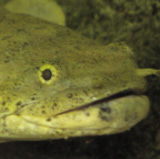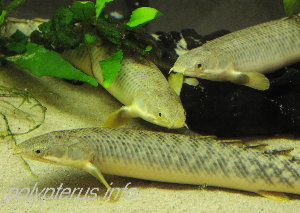

Tank Setup for Bichirs and Ropefish in the Aquarium
The tank
The first thing to consider is the size of tank required. This will of course depend on whether you wish to keep a single specimen, or several, and whether it will be a species setup or include a variety of other fishes.
As a general guide, the smaller Polypterus species and Ropefish can be accomodated in an aquarium measuring at least 122cm (48"/4ft) long by 38cm (15") wide. The smaller species of Polypterus would include members of the palmas species complex and P. senegalus. Most of these will typically reach 25-30cm (10-12") in aquaria.
A more suitable size to house a group of the small to medium-sized bichirs would be 153 x 46cm (60 x 18"). To house the larger species (e.g. P. ornatipinnis, P. endlicheri and the P. bichir species complex) a 183 x 61cm (6 x 2’) tank would be more appropriate. Juveniles can of course be "grown on" in smaller tanks initially.
The size of the base area is much more important than the height of the tank, so opt for a shallower tank with a large footprint where possible. Polypterids need to be able to reach the surface to snatch a supplementary gulp of air occasionally, and deep tanks will make this more difficult. The tank should never be so full that there is no air gap between the water and the cover. A tank 25-30cm (10-12") deep will be fine for juvenile Polypterus. 38-45cm (15-18") is plenty even for adult bichirs, and there is no reason to exceed 61cm (24") even for the largest species.
Tanks exceeding 45cm (18") in height should be constructed from at least 10mm glass. At least 6mm glass is recommended for smaller tanks, preferrably with a 10mm base on anything larger than 122 x 38cm (48x15"). One final point regarding the tank itself: use tight-fitting heavy covers - Polypterids are capable of escaping aquaria! Ropefish in particular have a reputation as escape artists and can squeeze through small gaps where tubing or cables enter the tank.
Decor
The substrate used for keeping Polypterus should be something which is easy to keep clean and provides a reasonably natural surface. The best choice for this is usually sand. When using fine sand, dirt tends to stay on top where it is easily siphoned away during water changes. With gravel, the fish waste, uneaten food, etc can fall into the spaces between the gravel. Only a thin layer of sand is needed, which avoids any problems with possible anaerobic areas (lacking oxygen) beneath the sand.
Soft aquarium sand, marketed specifically for aquarium use, is ideal. Other types which are usually ok include the fine sand used for children's play-pits/sand boxes (which is usually prewashed and sterile) or horticultural ‘silver sand’, usually available from garden centres. Pool filtration sand should also be ok, but it would be wise to avoid builder's sand as this could be very impure, and may increase pH and hardness.

Sand will make it easier for the bichirs to find food, and is easier to keep clean.
If gravel is used instead of sand, it should be recognised that there is a (low) risk of it being ingested and causing injury if not regurgitated. Although the fish would normally reject any gravel picked up with food, it might be wise to avoid gravel sizes that could be easily ingested by mistake.
The colour of the substrate used may have an influence on the colour and markings of your bichirs. Light coloured sand or gravel will tend to result in paler fish with faded markings. Conversely, dark coloured substrate will tend to produce bolder markings, but could make some species look uniformly darker. Red-coloured substrates, while not the most natural colour, have been shown to produce high contrast in bichir markings.
Personally, I am not in favour of keeping fish in bare-bottomed tanks, as I feel this is very unnatural. Unnatural surroundings could be a low-level stress factor for fish which may not be immediately evident. Sand or gravel substrates also add a large extra surface area for colonisation of beneficial bacteria. However, having bare-bottomed tanks does make it easy to keep the tank clean, and it probably won't cause any specific problems for bichirs if you choose to maintain them in this way.
Some suggest keeping Polypterus in bare tanks without décor, to reduce the chance of territorial behaviour. However, for me, an aquarium should be an attempt to create some resemblence of a natural habitat for fish, and not simply a plain glass box full of fish. Some may disagree with this opinion, but a more naturally decorated tank not only looks more attractive, it is also likely to make fish feel more secure if they have somewhere to retreat to. Fish often appear stressed as they huddle in the back corners of tanks with no decor.
Smooth rocks and larger pieces of bogwood, arranged to provide some caves, will provide suitable décor. An alternative that bichirs seem to like is ceramic or plastic tubes. These obviously don't look as natural, but they still provide suitable cover.
Bichirs can also be kept in a planted tank, although larger individuals are likely to uproot plants. Robust plants, and especially those that can be easily attached to rocks and wood - such as Anubias, Java fern and Java moss - are recommended. Floating plants can of course be used without problems, and it may be found that using a combination of floating plants and other decor will encourage the bichirs to use the upper levels of the aquarium more. Artificial plants could also be used to provide extra cover.
Equipment
Although these fish are not overly active or greedy feeders compared to some predatory fish, the meaty and high-protein foods they require could pollute the water quickly without adequate filtration. Filtration should therefore be of a type that ensures plenty of bio-filtration capacity - high circulation rates are less important. External canister filters are probably the most accessible large biofilter for most setups, though other efficient biofilters such as fluidised sand beds, and trickle filters can be incorporated. Sump filters are also useful as they usually have a large capacity for media, they increase the overall volume of the system, and equipment such as heaters can be placed in them rather than the main tank.
Any modern heater capable of keeping the temperature at the upper end of the tropical range (25-28oC / 77-82oF) should be suitable. Some sort of heater guard should be used, to prevent accidental damage to the heater by these powerful fish. Some newer premium designs include 'unbreakable' heater materials. Another option is to keep the heater outside of the tank altogether, either by using an external canister filter incorporating a heater (thermofilter) or an external sump. Some manufacturers also produce an in-line heater which can be plumbed into the return tubing from a canister filter.
The lighting used is not too critical unless you opt for live plants. As bichirs are more active at night, they are likely to prefer dim lighting, although juveniles in particular do not appear to be bothered by brighter light at feeding time. The blue ‘moonlight’ type fluorescent tubes or blue LED lights can be used to good effect for evening viewing. Many modern LED designs can also be dimmed gradually so that day/night cycles can be programmed. Increased activity is frequently observed when the main tank lights are off.
